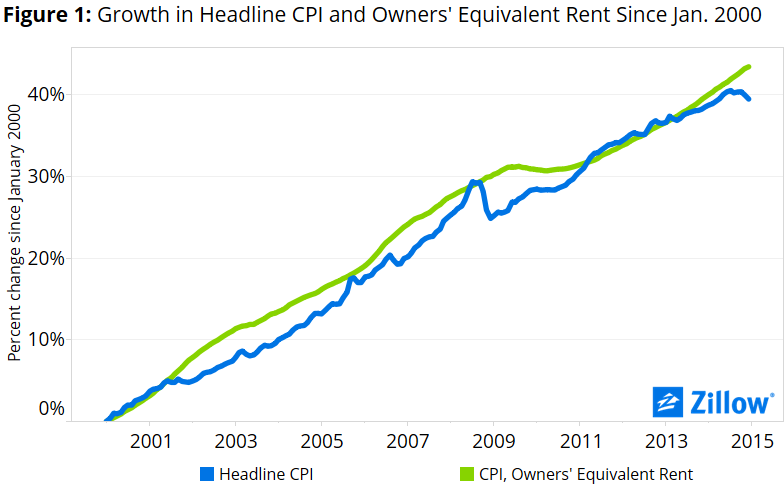This morning the Bureau of Labor Statistics (BLS) released its December 2014 Consumer Price Index (CPI) data, one of the two main data series used to measure how prices change in the United States. CPI data are produced from the results of the BLS Consumer Expenditure Survey (CES). The CPI data include a number of sub-indices for particular goods, including estimates of housing prices.
For homeowners, the CPI series on Owners’ Equivalent Rent (OER) is designed to gauge how much homeowners’ shelter costs contribute to changing prices. This is particularly difficult since, unlike other goods such as groceries or cars, most homeowners’ monthly housing costs do not change much on a month to month basis due to the prevalence of fixed-rate mortgages.
To get a better sense of how much homeowners’ shelter costs are changing, the CES asks homeowners the following question: “If someone were to rent your home today, how much do you think it would rent for monthly, unfurnished and without utilities.”
One unique feature of the OER series is that, unlike most housing price or housing value indexes including the Zillow Home Value Index (ZHVI), during the 2000s the OER series did not suggest a rapid run-up in shelter costs in advance of the Great Recession, or a steep drop in shelter costs during the housing bust. Instead, the OER series grew steadily from 2000 through 2009 – roughly in line with the growth of all prices – before flattening out in 2009 and 2010. Since 2010, the OER series has resumed its pre-crisis trend.
Part of the difference between OER and most other housing indices is the formulation of the question. The CES question mixes purchase prices and rent prices. Since rents grew slowly during the housing bubble but grew quickly during the housing bust, owners may have been focusing more on trends in their local rental market rather than trends in their local purchase market when responding to the survey. Regardless, the absence of an obvious housing bubble or bust in the OER series, and its differences to most other home price/value indices, raises questions about what exactly is being measured.
